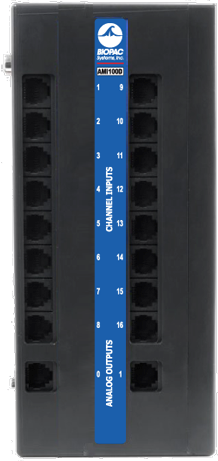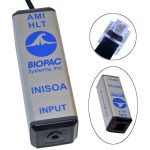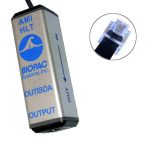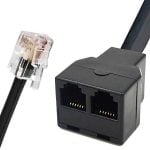High-level output transducers and adapters connect to the AMI100D via standard RJ type connectors. Transducers and adapters that interface with the AMI100D module include:
- TSD109C3/J1 Tri-axial Accelerometers
- TSD111A Heel/Toe Strike Transducer
- TSD115 Variable Assessment Transducer
- TSD150A/B Active Electrodes
- INISOA Adapter – Input Signal Isolator
- OUTISOA Adapter – Output Signal Isolator
- CBL237 Output Interface (Y adapter)
- DTU100 Digital Trigger Unit (MRI Synchronization)
- STP100C Isolated Digital Interface
- STM100C Stimulus Module for Pulse & Waveform Output
To provide the maximum in subject safety and isolation, use electrically isolated signal adapters to connect mains powered external equipment (i.e., chart recorders, oscilloscopes, etc.) to the MP System. Use the INISOA adapter to connect to MP160 analog system inputs and the OUTISOA adapter to connect to analog system outputs.
Specifications
Modular Jacks: Channel Inputs 1-16; Analog Outputs 0-1
Ground (GND) for any custom high-level transducers: Pin 2 of the RJ12 connector
Smart Amp Communication: Pin 5
Compatibility: To enable full communications with Smart Amplifiers, the AMI100D must be used with an MP160 that is running firmware version 2.1.0 or higher.
Important! AMI100D cannot physically be used with an IPS100C or an MP150+UIM combination. IPS100C and MP150 require HLT100C-MP150.
Dimensions: 7 cm x 11 cm x 19 cm
Weight: 540 g





Stay Connected